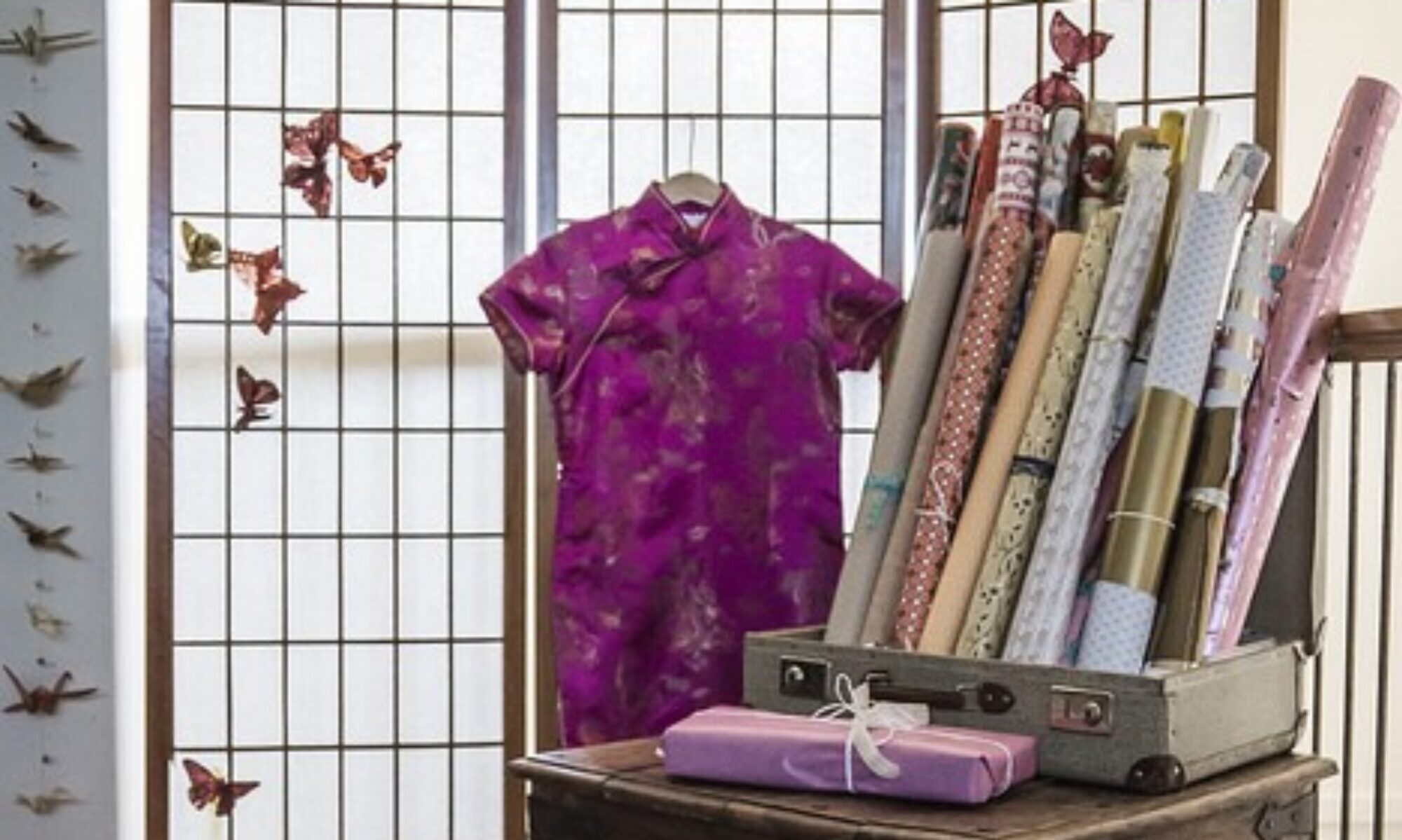.APPLY LEAN AND SAVE THE PLANET AND YOUR MARRIAGE – (OR YOU CAN SAY LEAN IN AND REDUCE YOUR ENVIRONMENTAL FOOTPRINT AND EMOTIONAL LABOR…)
One piece I wrote for iSixSigma.com a leading publisher for the Lean community.https://www.isixsigma.com/lean-methodology/apply-lean-to-save-the-planet-and-your-marriage/
Ever wondered how LEAN can help you save both the planet and your marriage? This is the story of how – out of pure survival instinct – our family began to implement LEAN in our daily lives and how this inspired thousands of others to do the same – with sustainable and measurable result. In this piece, I will introduce the approach, share some practical tools, and do my best to inspire you to achieve the same impact.
While our kids take action for the climate by marching the streets as part of Fridays for Future, inspired by Greta Thunberg, many of us continue our own career march five days a week, culminating in a weekend at long last. We try to juggle hectic work agendas with a busy family life and other obligations in an often stressful process that isn’t sustainable – not for us as individuals, not for our relationships, and not for our climate.
This is the burning platform: the sad truth is that most readers of this piece probably have an ecological footprint amounting to four or five planet Earths (i.e., we would need at least four planet Earths if everyone lived the same way)[1]. Scientists have shown that we are the last generation that can stop climate change. [2]Meanwhile, research shows that many people live in marriages in which one individual is overburdened and takes on most of the practical, logistical and emotional responsibilities in the household. [3]
But we can do much better than that. We are much better.
One way to make a change without a huge paradigm shift is to start with two simple yet challenging lean principles: continuous improvementsand respect for people.
Start with small, sustainable steps in the organization you can impact most – your own home and daily life.
Survival instinct
As I said, for us it all began out of pure survival instinct. To overcome the challenges of a life filled with stress, waste and frustration, we started implementing lean philosophy into our home, an old wooden house with a small apple orchard outside Stockholm. It was unintentional at first, but as we saw the pattern emerge like interwoven threads forming figures in a tapestry, we began to systematically work with lean tools and philosophy.
My husband and I both had experience with lean from business and health care (I was vice president of a global telecom company; my husband is a doctor). Our son and two daughters helped with the change. After only one year, we saw astronomical results. We cut our expenses in half; we went from almost no control to full control, and we have flow in our daily lives. We started to achieve our family’s dreams, and after less than a year, our environmental footprint was one third of what it used to be. The laundry was ten times faster, and we no longer wasted thousands of dollars in living space. We went from a feeling of frustration to flow. My husband went from a beer belly to a triathlete and I decided to live my dream of writing books. We shifted from a life permeated by waste into one filled with value.
Once we saw this impact, we felt obliged to share it. These ideas have now been translated into books and articles in many languages, and I receive feedback daily. But doing this was a huge step outside of our comfort zone.
Opportunity in disguise
When I talk about lean management versus conventional management, I sometimes simplify and say that lean management is intended to highlight problems, which are actually seen as something positive – as an opportunity in disguise (how I love that definition!). Conventional management seeks to ignore problems, to hide them under the rug – problems are bad, people get blamed.
Could we say the same thing about (conventional) marriages? Are we only seeing problems as bad? Do we blame our partner?
If the answer is yes, then try to lean in, even in your marriage. Try to see problems as opportunities in disguise; try to ask whyto get to the root of problems, instead of playing the classic blaming game with a focus on the symptoms.
One of today’s major challenges is family logistics and the emotional labor that tends to fall on one person’s shoulders – often on women’s shoulders, and often highly involuntarily (emotional labor is quite a Sisyphean task, because it is done seamlessly, invisibly). But here’s the thing: it really needs to be addressed, because if someone deeply feels they are being taken advantage of, it is a direct threat to the atmosphere of the home. I encourage people to really think about who does what and why – and how to do things smarter, in a more fun and creative way. Imaginethis: you have a team at work of four or five colleagues, and only one of them – always the same one – takes care of everything. That organization is doomed. This is often the case in the family: you have one person who often involuntarily falls into that role.
Who did you fire?
As you know, even workloads and putting everyone’s creativity to use are key elements of lean culture (one of the biggest wastes is not leveraging the creativity of everyone who wishes to contribute.People should not be overburdened (Muri), nor have vastly uneven streams (Mura). I mean that. Whether consciously or unconsciously, a number of organizations have grossly misinterpreted or manipulated lean, giving it a bad reputation in some circles. These organizations seem to think lean is about an insane amount of streamlining, overburdening employees, and reducing staff. It should be the opposite: it’s impossible to have a lean culture if your staff is overburdened, which more and more companies are realizing. And that is NOT respectful of people. This was actually the first question I got from a journalist when I released my first book: “Who in the family did you fire?”
The same goes in your micro-organization, the home. It is often the interplay between parents that indicates the atmosphere in the home. Obviously, the practical and emotional sides of being a good parent must be discussed and shared. Shirking responsibility is inconsistent with a desire to be a lifelong good parent. It is awful to feel that you’ve been taken advantage of, and that feeling is a direct threat to the atmosphere of the home.
Invisible tasks
Try the following exercise: each of you should have your own sheet of white paper in front of you. Draw two or three columns, with one column for each adult. If you have children, label one column for the kids. The first column is yours: write down the percentage of chores you believe you do, and what they are. The second column is your perception of your partner: write down how much and what you believe they do. In the third column, do the same for the children. Your partner should do the same. If your kids are old enough, they can join in and draw columns indicating how much of the total housework they believe they do.
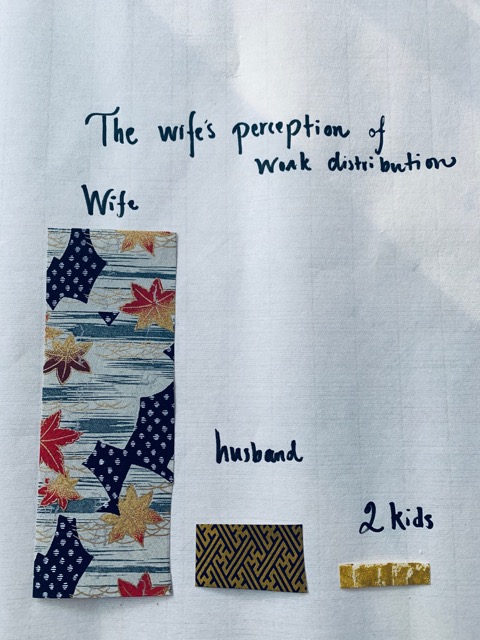
This is one lens through which to view your parenting, and a way to estimate the distribution of responsibility. If both parents work full-time, then ideally, the columns should be the same size. When you complete this exercise, it is important to truly consider everything you do at home, including social, emotional, practical, and financial work.
This exercise is about perception, appreciation, and acknowledgment.
Label your column with what you do and how much time it takes. The next step, which may be amusing or may be worrisome, is to compare your estimate to your partner’s. There are so many things that one partner does of which the other may be completely unaware, and vice versa. They are invisible. Things only become apparent when they are not done.
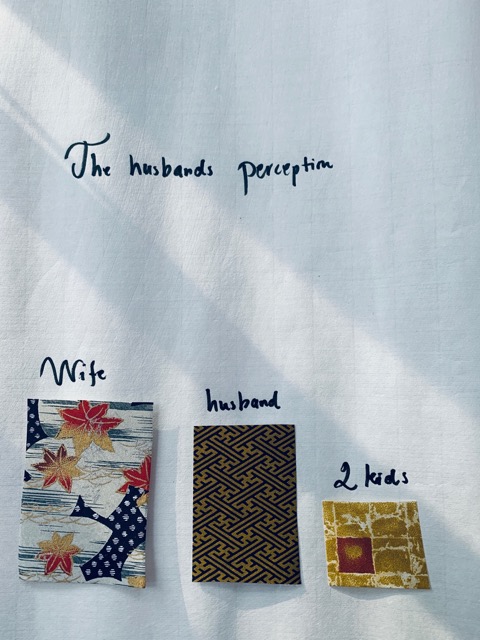
It is incredibly easy to do. Write down everything, and I mean everything, big and small. Don’t be sloppy and don’t forget anything – that is key. Everything counts, from charging the lawnmower battery to buying new gym shoes for the kids, from wiping crumbs off the dining-room table to driving the kids to their activities.
Ecological footprint.
When we started practicing lean at home, we genuinely believed (rather naively) that we were already environmentally friendly. But when we calculated our carbon footprint, we were shocked. It was a real eye opener for us. If everyone lived like we did back then, we would need eight Earths! Today we are down to between two to three – but we really haven’t gone far enough.
There are several ways to calculate your own carbon footprint. One tool that I find to be straightforward and intuitive is the Footprint Calculator at www.footprintcalculator.org. It’s easy; you simply answer questions about your home, travel, eating and shopping habits. Then the calculator reveals your environmental impact and suggests ways to reduce it. You can choose to answer at two levels, either an average, or by adding details to improve accuracy.

It will take you about 10–15 minutes and you will be so much more aware of where your waste lies. What we realized when we started to reflect on this was how we neglect our most important needs (breathing clean air, drinking clean water etc.) to meet compensatory needs created by effective marketing messages.
Because what this is actually about is how to move from waste to value.
According to the United Nations, we are the first generation ever that can end all poverty in the world – and the last one that can stop climate change. So I believe we just have to start. While our kids are marching, we can take those small sustainable steps.
[1]https://www.weforum.org/agenda/2019/01/chart-of-the-day-these-countries-have-the-largest-carbon-footprints/
[2]https://www.un.org/press/en/2019/ga12131.doc.htm
[3]https://stats.oecd.org/index.aspx?queryid=54757
One piece I wrote for my publisher in UK in August 2019. It is an honest attempt to contribute more equal homes were both parents share the emotional labour.
CONQUER BACK TO SCHOOL CHAOS WITH COLLABORATION AND KAIZEN
There are so many blogs, tips and checklists on how to cope with the back to school chaos – and most of them are targeted at mums. But this piece doesn’t just have women in mind (let’s face it, so often the burden of home organisation falls to the mother). Since I’m elite-trained in optimism I hope it will be read by all kinds of family dynamics: mums, dads, couples and single parents.
Have you been worried about the mayhem of getting the kids back to school? Do you start to feel distress and discomfort by the end of the summer break at the mere thought of all the school paperwork, new routines, planning and preparing lunchboxes, the logistics around after-school activities and horrible, hectic mornings? If the answer is yes, the likelihood is that you’re a woman. If you are a man and the answer is yes – then hurrah! – you should be proud that you are modern dad.
However, if you haven’t worried at all about the prospect, then there’s a risk that you may have, (unintentionally) abdicated from your important role to emotionally participate and contribute to the everyday life of the people who matter most to you – your children.
Here is an opportunity to change that.
Eight years ago our family started to use the Japanese Lean philosophy, out of pure survival instinct. At first it was unintentional, but when we saw a pattern emerge, like interwoven threads forming figures in a tapestry, we realised we were using some tools from Lean. Then we decided to try it in a more strategic, systematic way. After less than a year we saw an amazing, astronomical impact; for instance, we cut our expenses in half, the environmental footprint was one third of what it used to be and we had flow and fun in our everyday life – instead of being frustrated and trying to escape it. Today this approach has inspired thousands of families and I get feedback every day from readers, many of whom are fathers who have started to be much more involved in the home. Lean and lean living is quite straightforward and is rooted in common sense. It has traditionally been applied in business with the aim of making make systems flow smoothly within an organisation. And the home is a kind of organisation – actually the organisation we can impact most.
Imagine this – you have a team at work with four or five colleagues, and only one, always the same person, fixes everything. That organisation is doomed. This is quite often the case in the family, you have one person, that often involuntarily falls into that role. If this is ringing a bell for you, here’s how it can be reversed – Kaizen.
Kaizen is the Japanese philosophy of continuous improvement. Reflect on how some of the critical back to school streams work at your home, for instance, the morning stream (from the time you wake up until you are where you are supposed to be). Here’s a mother’s example of her four-member family morning stream, it is from a feedback from a reader.
Every morning the word “Hurry!” echoes throughout the flat. The stream starts from the time she finally falls asleep at 1am after scrolling through everyone’s picture-perfect lives on Instagram. Five hours later, the alarm wakes her up and she starts immediately checking her work emails before a leisurely ten-minute shower to wake herself. Her mind elsewhere the whole time, she shouts at her kids to ‘hurry!’. In her haste, she forgets their homework and drops them off late to school. When she finally arrives at work, she is distracted by thoughts of her children, their lateness and forgotten home- work. When she gets home in the evening, she is welcomed by that morning’s mess: breakfast dishes on the table and unmade beds, which makes her angry at her partner, who avoided having any responsibility. It was a vicious cycle that needed to end and here’s how Kaizen came in.
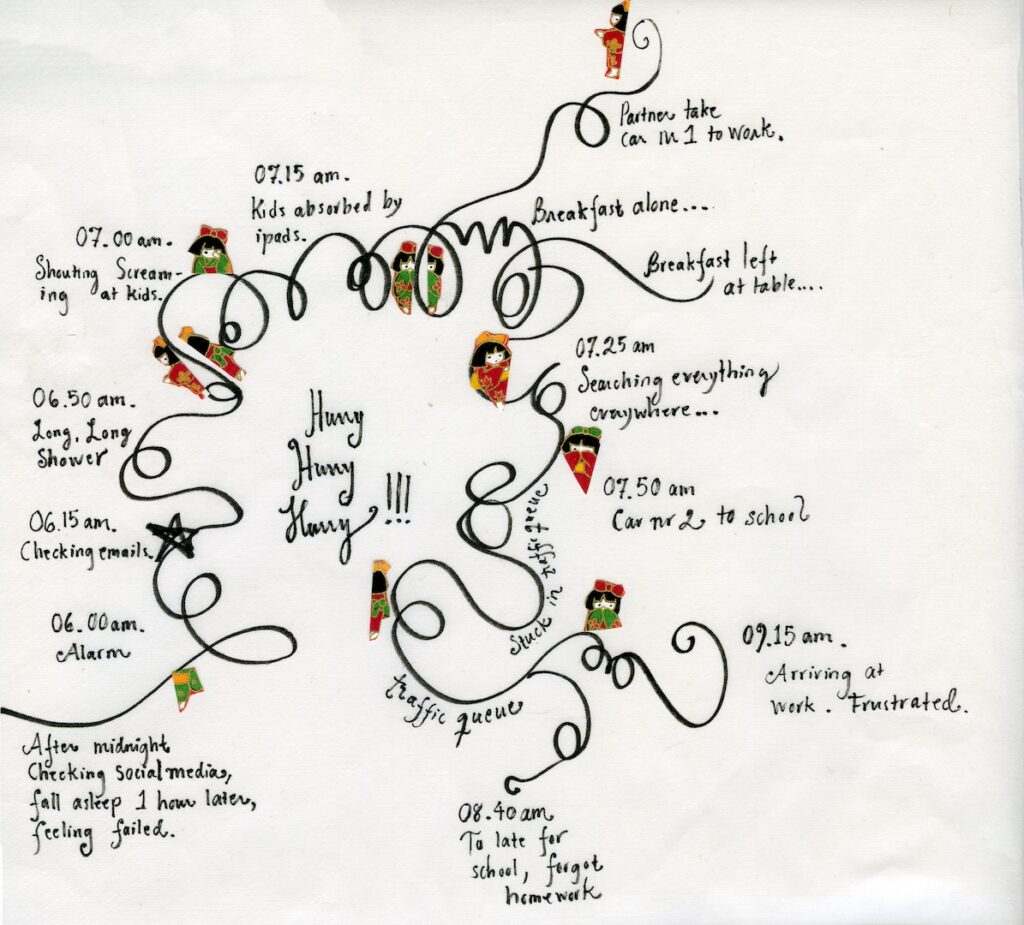
With the help of Kaizen the family agreed they needed to change the morning stream, it just wasn’t sustainable. The first step was working out that one parent could cycle with the children to school and then on to work instead of driving. They sold one of their cars, reducing their carbon footprint. The other parent now takes public transport, using the free time to listen to audiobooks, and arriving to work feeling more calm. They have agreed as a family not to use their mobile phones or tablets in the morning apart from as an alarm. In the evening before they pack and plan the outfit for the next day. Together they have transformed waste to value, and the morning stream is something they look forward to.
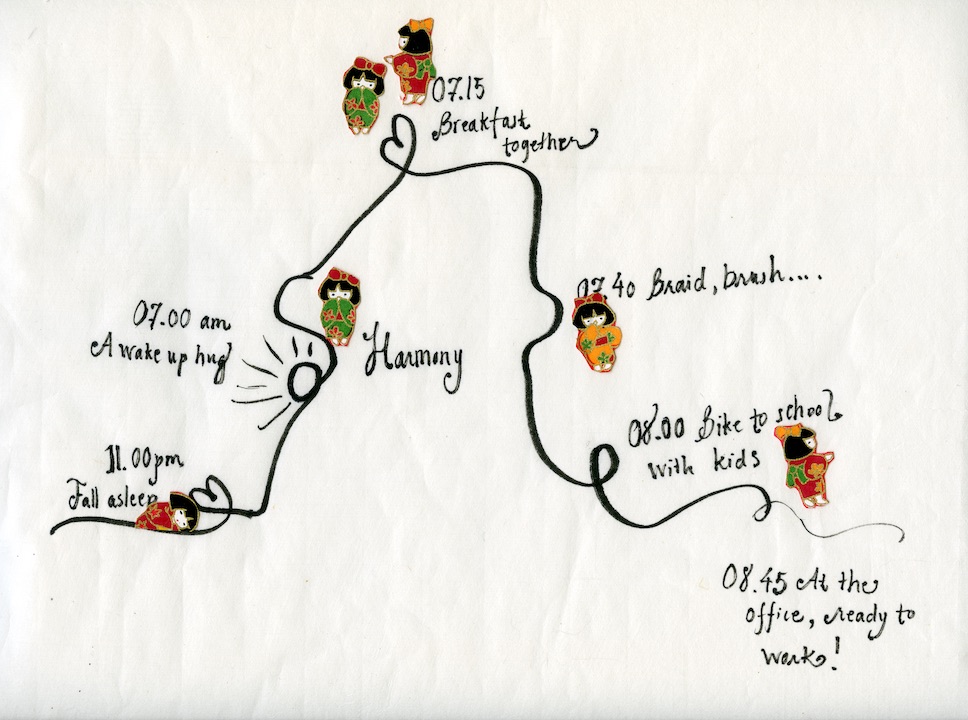
Everyday life is full of these kind of streams; the bedtime stream, homework stream, lunchboxes stream, activities stream, dinner stream, laundy stream etc.
So sit down and reflect on which of your daily streams need attention. If we focus on the back to school chaos it is probably the morning, homework, every day dinner and bedtime streams that are some of the most important,
Kaizen is built on five steps. Adopt these and you’ll notice a big change at home:
STEP ONE: asses your current set-up – what works and what doesn’t – and try to identify the real reasons behind the problems.
STEP TWO: agree on your desired solution, i.e. how you want things to be. This should be a reachable and inspiring goal.
STEP THREE: decide upon new habits, that are easy to maintain.
STEP FOUR: start practising the new habits within that same week.
STEP FIVE: follow up after approximately 30 days, because that is, according to many researchers what it takes to create new habits. Make sure your changes are lasting and sustainable. And don’t forget to celebrate!
You could say that the The Lean and Happy Homeis a manifesto for the modern home, where both parents want to be involved and have an impact in their children’s lives. It’s about creating a sustainable home: sustainable relationships, a sustainable society and to sustain as an individual in this time where there is so much pressure on us. This book gives you the tools to change your unique reality Lean helps us to live and contribute the best and kindest way we can, all that it requires is love, intention and some perseverance. Go on – give it a go!
